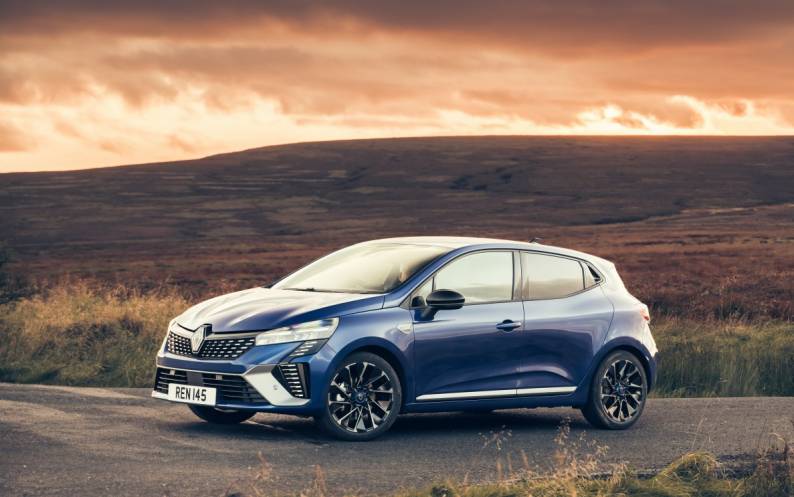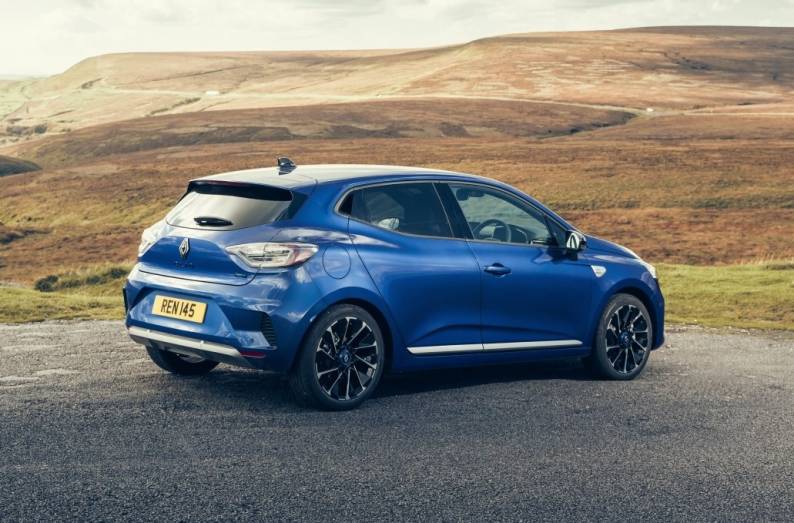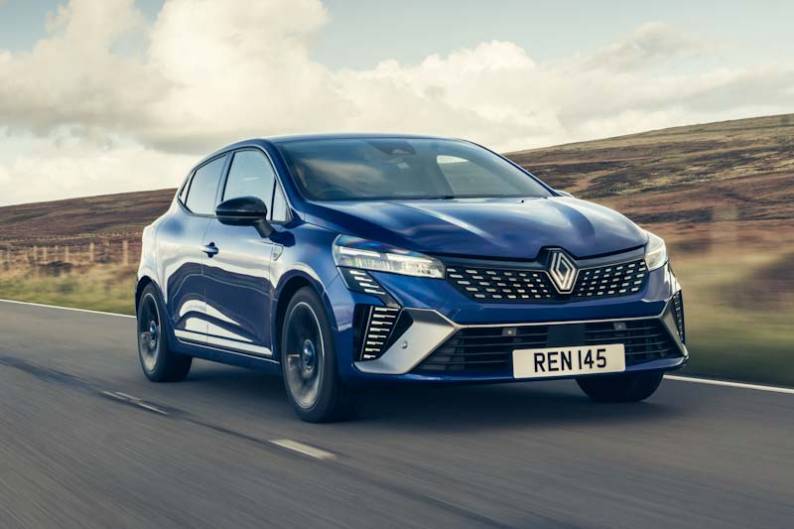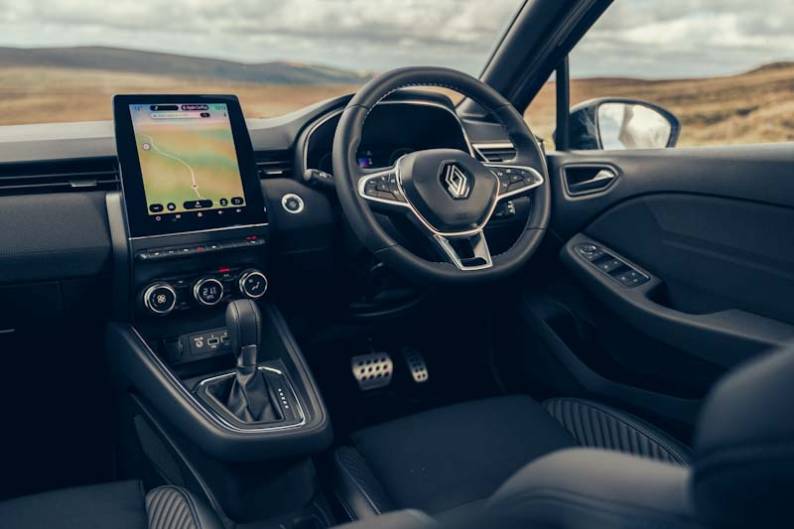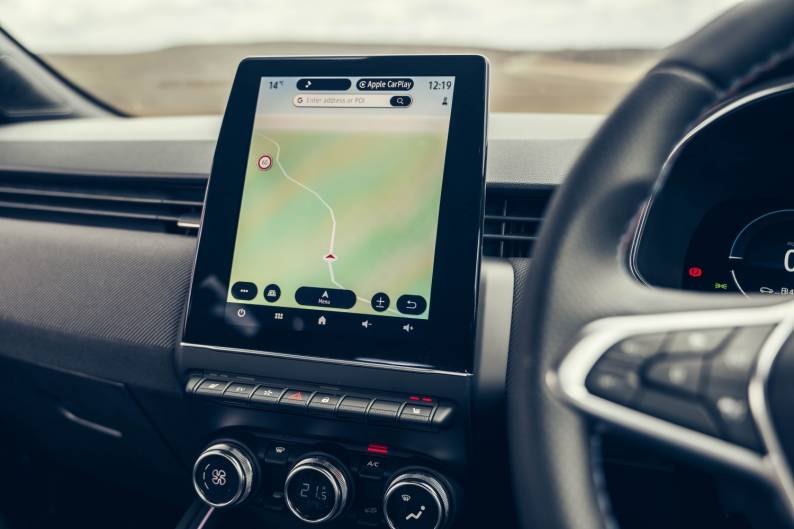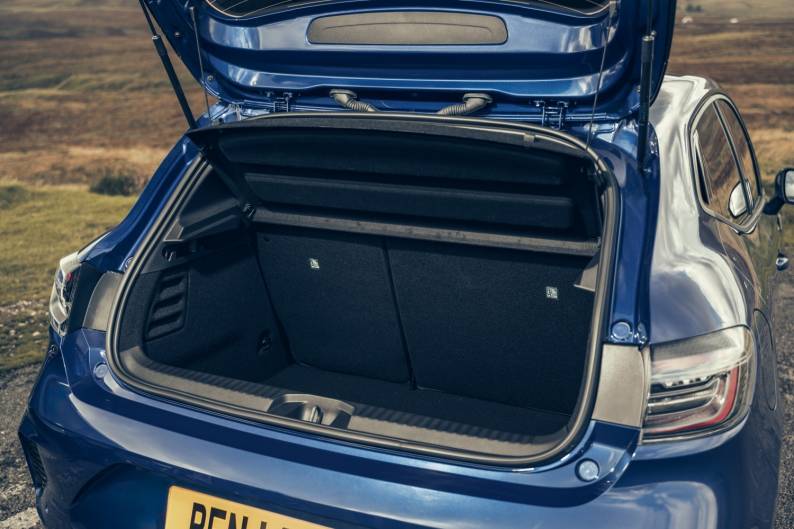
RAC sale – up to 33% off*
• Roadside cover from £5.29 a month†
• We get to most breakdowns in 60 mins or less
• Our patrols fix 4/5 breakdowns on the spot

Things you'll like
- Keenly priced for a hybrid
- Smooth around town
- Great fuel economy
Things to consider
- Boot space is reduced over petrol Clio
- Misses out on Renault’s Google tech
- Refinement issues out of town
What is the Renault Clio E-Tech Hybrid?
It’s the stepping stone of electrification that’s lead to the fantastic, award-winning new Renault 5 – the car that’s been stealing all the limelight since its unveiling in 2024. But the hybrid-powered Clio, still fresh after a mid-life refresh at the end of 2023, remains relevant today.
You see, while there’s a growing market for small electric cars and plenty of great examples to choose from, they certainly aren’t for everyone. Research from Lloyds Bank suggests 44% of UK homes are not suitable for home charging an EV or plug-in hybrid, while the high cost of public charging means that those without suitable home charging could be out of pocket if they switched to electric.
That’s why traditional hybrids such as the Clio E-Tech remain popular. Like Toyota’s tried-and-tested ‘self-charging’ hybrid system, the Clio never needs to be plugged in to top up its battery but can still run around town for a certain amount of time in emissions-free electric-only mode.
The E-Tech system in this latest Clio isn’t drastically different, but minor updates along with styling tweaks, interior and equipment improvements aim to ensure the French small car isn’t old-hat in the face of Renault’s funky new small EVs. But is it still a small hybrid worth buying? We’ll find out in this review.
Verdict: is the Renault Clio E-Tech Hybrid a good car?
If you’re after a small hybrid car that’s affordable to buy and run, stylish, nice to sit in and good to drive, then you can’t go far wrong with the Renault Clio E-Tech. It’s a shame the tech is a little dated next to Renault’s snazzy EV offerings, but there’s still plenty to like with Renault’s popular supermini.
Pricing, specs & rivals
The Clio’s pricing puts it among the cheapest hybrid cars on sale, as it usefully undercuts rivals from Honda, Toyota and Mazda. Only the remarkably affordable MG3 Hybrid+ is cheaper still.
Prices kick off from £21,895 at the time of writing (April 2025). That gets you into entry-level Evolution spec and represents a near-£2,000 increase over the petrol TCe 90 version. To compare, the cheapest MG3 is a remarkable £18,995.
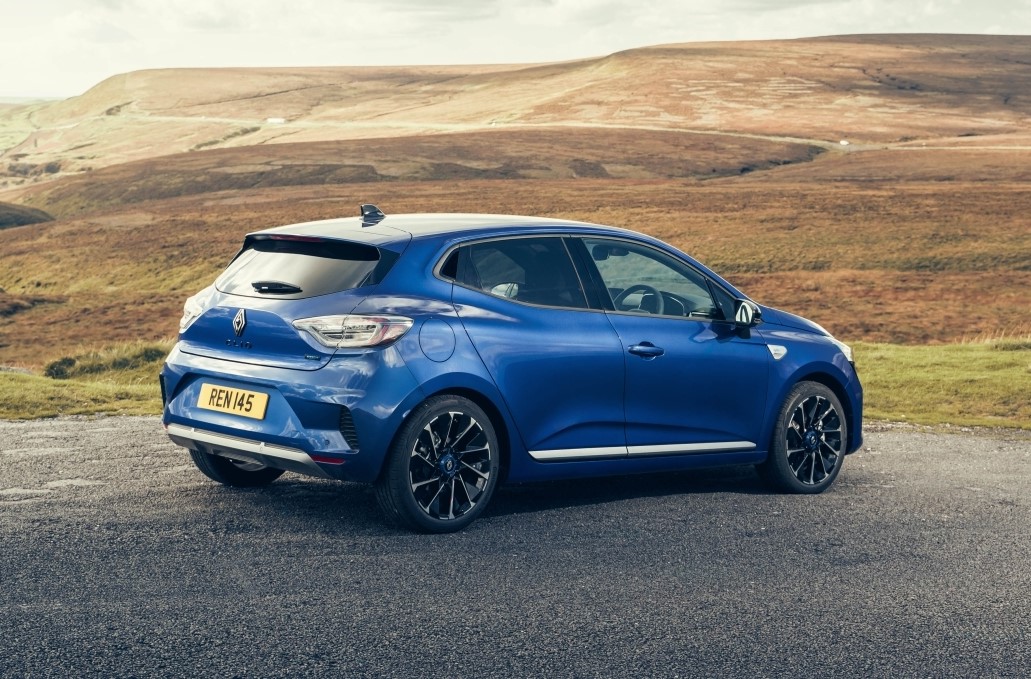
Upgrading to Techno trim increases the Clio’s starting price to £23,495, while the flagship esprit Alpine model is £25,095. These trim levels replace a more complicated array of variants in the pre-facelift model.
Evolution trim isn’t by any means sparse, including equipment such as full LED headlights, auto lights and wipers, 16-inch alloys, climate control, keyless start, cruise control, rear parking sensors and a seven-inch touchscreen with built-in sat-nav.
Upgrading to Techno trim brings 17-inch alloys, upgraded exterior styling, a leather steering wheel, front parking sensors, a rear-view camera, keyless entry, upgraded interior trim and a wireless phone charging pad.
Topping the revised range is esprit Alpine trim, which as the name suggests brings sporty visual additions from the brand that brought you the A110 sports car – sports seats and upholstery upgrades, too. It also upgrades the infotainment system and instrument display too.
Rivals
The standard Clio has a huge array of rivals, but not all of them are available as a full hybrid. If that’s a priority then you’ll want to check out the Toyota Yaris and the mechanically identical Mazda 2, the Honda Jazz and the MG 3 Hybrid+.
There are some mild-hybrid alternatives, too, such as the Suzuki Swift and Hyundai i20. Meanwhile, if you feel ready to make the leap into fully electric motoring then the fantastic Renault 5 EV is well worth a look.
Renault Clio E-Tech Hybrid : Interior comfort, quality & technology
The updated Clio has had some noticeable visual upgrades on the outside, but inside it’s pretty much business as usual. That means it misses out on the wow factor of the Renault 5, for example.
But that’s not too bad. This generation of Clio has been around since 2019, but even today the cabin doesn’t look or feel dated in most areas – blending a pleasant design with intuitive, easy controls. New details such as smart sport seats and dash and door trim upgrades for Esprit Alpine help life the top models, too.
Granted, there are some areas where cabin quality can’t match up to bigger Renaults: the slightly wobbly centre console and less-than-plus door elbow rests, for example. But overall it’s still nice: Techno trim and above bring plenty of soft-touch finishes, appealing fabrics and ambient lighting, meaning the Clio looks and feels posher inside than a Toyota Yaris or Hyundai i20.
Details like the easy-to-use steering wheel controls, physical shortcut keys and – praise be – some tactile rotary controls for the climate functions mean it’s a cabin you can climb into and get on with easily.
Visibility is decent, too – despite chunky front pillars, they’re angled well enough to not get in the way at junctions, while the windscreen and side windows are big. Rear visibility isn’t the best, though – a Honda Jazz is easier to see out of. All Clios get rear parking sensors at least, while front sensors and a reversing camera come with Techno trim.
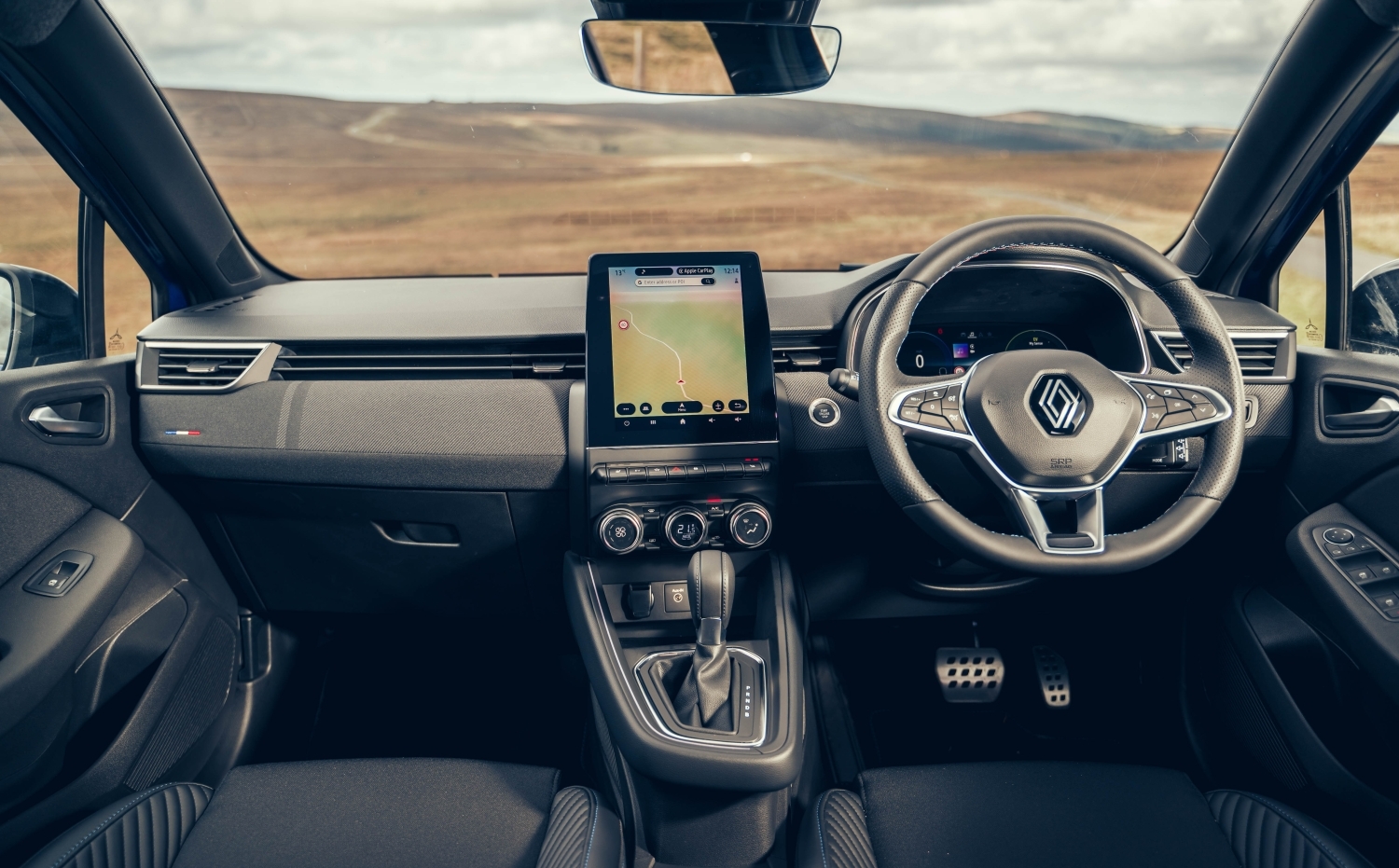
Infotainment, sat-nav, stereo and connectivity
Perhaps the only slightly disappointment with the Clio’s cabin is the infotainment, which is an older system than you’ll find in newer Renaults. In Evolution and Techno trim you’ll make do with a seven-inch screen, rising to 9.3-inches in the Esprit Alpine.
The smaller screen isn’t bad, with smart enough graphics, but it lacks the snappy responses of the newer system. You also still wireless Android Auto and Apple CarPlay, plus-built-in sat-nav, but it’s Renault’s own system rather than the brilliant integrated Google Maps you get in the Renault 5 and Megane E-Tech.
You also miss out on the intuitive Google Assistant voice control, too, plus various other features the newer software provides. Esprit Alpine models get a larger, portrait-angle 9.3-inch touchscreen that’s easier to operate than the smaller screen and looks better, but still lacks the Google tech.
Most versions get a fairly basic seven-inch instrument display flanked by old-school LCD readouts for the temperature and fuel gauge. It’s easy to read and fulfils the basics, but tech-savvy folk will want the customisable 10-inch display of Esprit Alpine spec.
All cars get a pair of USB-A connectors and an Aux-in input (both rather date the car) and no charging connectors for the rear seats at all, which is a pity. Still, the standard four-speaker audio system delivers decent sound quality for a small car.
How practical is the Renault Clio E-Tech Hybrid?
The updated Clio hasn’t really change in terms of exterior dimensions, with its length of 4,053mm, width of 1,798mm and height of 1,440mm making it shorter and lower than the MG 3 and Honda Jazz but longer than the Toyota Yaris. The Clio is very similar in size to the Hyundai i20.
Those looking at the hybrid will be pleased to know that no passenger space has been sacrificed over the petrol model (the boot, sadly, is a different story). There’s plenty of head and leg space up front for those over six-foot, while decent cabin width means only the exceptionally broad will be fighting for elbow space on the centre armrest.
Rear space isn’t outstanding by small car standards, but the Clio isn’t overly cramped for a small car. Six footers will find that their knees are brushing the seat in front if there’s average-sized adults up there, while headroom is acceptable rather than generous. An adult in the rear middle seat isn’t going to be happy for anything more than a quick lift to the pub.
Overall, the Clio E-Tech is roomier than the Toyota Yaris in the back, but not as generous in space terms as the MG 3 or Honda Jazz.
Storage and boot space
Storage in the Clio is pretty good overall for a compact car, but again some way behind the Jazz. The glovebox is a good size bar the intrusion of the fusebox, the door bins can just about take big water bottles and you get a deep but narrow cubby beneath the centre armrest.
You also get a pair of cupholders in the centre console and a phone storage area. The rear door bins can fit a pair of smaller water bottles, while there are pockets in the front seatbacks too. It’s a shame there aren’t further cupholders in a fold-down centre armrest, but most other small cars don’t have one either.
The one key practicality niggle specific to the hybrid version of the Clio is boot space. In the TCe 90 petrol model it’s impressive at 391 litres – more than a Volkswagen Golf. However, due to the hybrid’s battery and electrical gubbins under the boot floor, it’s reduced by quite a bit.
At 301 litres in capacity, that’s at least still bigger than a Toyota Yaris and MG 3’s boot, and only a few litres down on the Honda Jazz’s. But It’s worth thinking about if you’ll be using the Clio for the weekly shop.
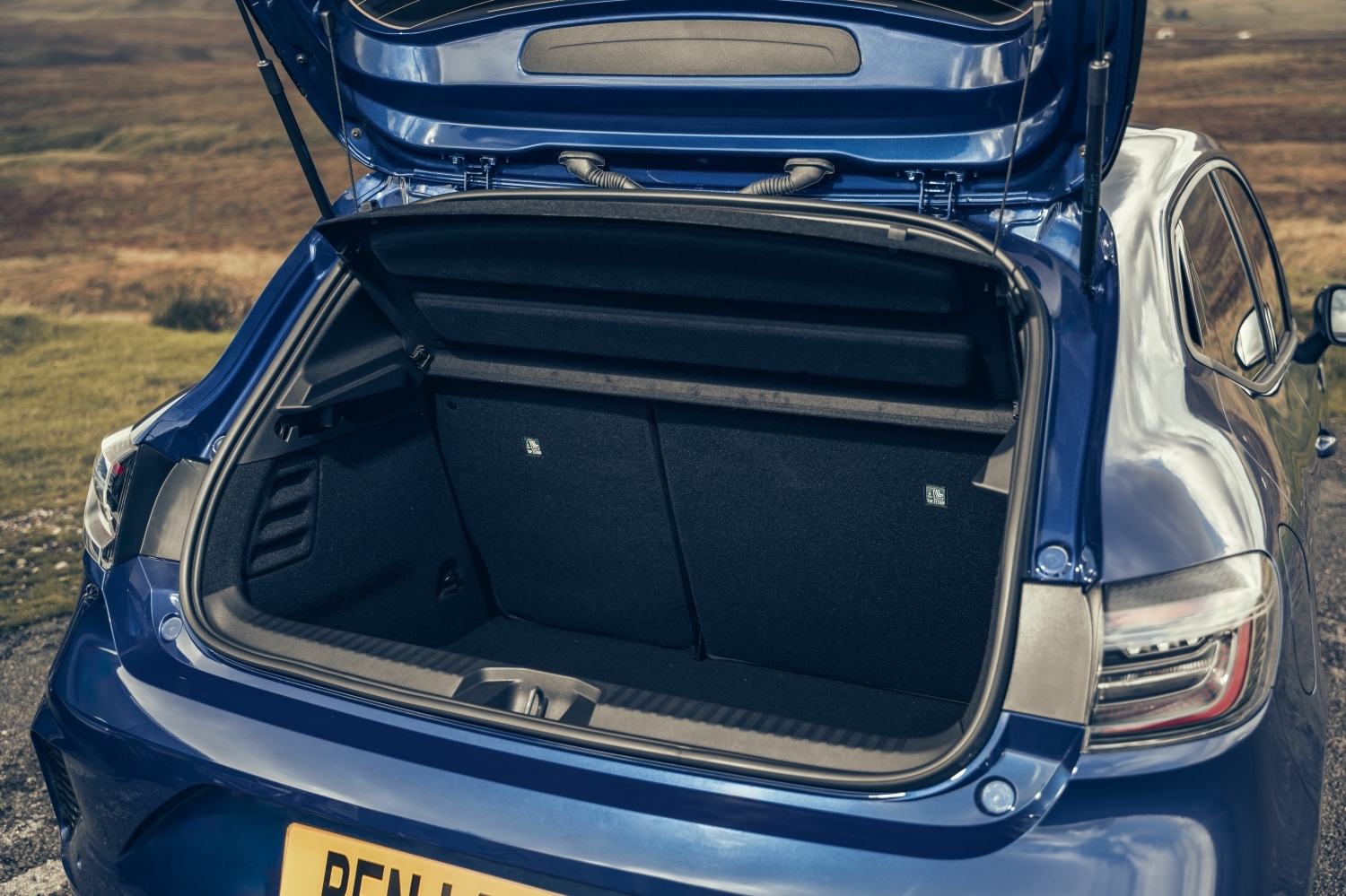
The hybrid model also loses the adjustable boot floor that the petrol model comes with, meaning you have a sizeable load lip to lug heavy items over and another hump at the other end of the boot if you fold the seats down (the Clio’s seats have a typical 60/40 split). That’s a shame, but again it’s unlikely to be a deal-breaker for many people.
Performance & drive: What is the Renault Clio E-Tech like on the road?
The Clio’s hybrid system is definitely at its best in urban settings, where it’ll make use of the car’s 1.2kWh battery to keep the engine off as much as possible and mooch about on electric power alone.
If you know anything about batteries you’ll know that’s only enough for a few miles of electric running on its own. But because the Clio’s 1.6-litre non-turbo petrol engine can fire up smoothly and charge it up quickly, Renault reckons you’ll manage to run in electric mode for 80% of the time around town – and you can do so up to about 40mph if you’re gentle with the throttle.
It’s smooth and responsive in this mode, too. Things are a bit different when the engine is running, though. Unlike a Toyota Yaris, the Clio features too electric motors – one powering the wheels and one firing up the engine and smoothing out gearchanges. It also uses a clutchless four-speed automatic transmission rather than the more usual CVT gearbox.
It’s a system used across various Renaults and Dacias (as well as the Nissan Juke) and it received a small 5hp boost with the facelift. With 145hp powering a small car like the Clio performance is quite strong and it’ll get up to motorway speeds with ease.
Sadly, the gearbox takes some getting used to. With only four speeds at its disposal, you’ll often find the engine either running at unusually high revs even when cruising or refusing to kick down and give you full power – there’s no manual mode to force gearshifts either. When shifts do finally occur, they’re painfully slow – but thankfully this isn’t often in normal driving.
Thankfully, the brake pedal has a natural response to it, and you can easily shift into ‘B’ mode on the gearlever to gain stronger regenerative braking effect.
Power, 0-62mph times
- Clio E-Tech Hybrid: 145hp/ 9.3 secs
Ride and handling
While the Clio E-Tech’s hybrid powertrain doesn’t encourage keen driving, the car’s chassis remains the same – and that makes it one of the best driving small cars out there.
The Clio feels light on its feet and agile in or out of town, helped by direct, confidence-inspiring steering, plenty of grip and limited body roll – it’s certainly more engaging than a Honda Jazz or Skoda Fabia.
There isn’t much in the way of compromise for this sharp handling when it comes to ride comfort, either, particularly if you opt for Evolution trim with the smallest wheels. In this spec it rounds off the edges of sharp bumps and potholes smoothly while feeling composed and stable at speed.
Models with 17-inch wheels have a bit of a firmer edge to the ride around town, but they’re never crashy or uncomfortable. Overall, the Clio is considerably better to drive than the MG 3.
Noise and refinement
The Clio manages to keep road and wind noise at bay pretty well, while suspension noise isn’t noticeable either. The main source of noise is the petrol engine when it kicks in to charge the battery, and particularly when its at certain speeds where the gearbox holds revs unusually high. It’s a minor irritation, but if you regularly drive down the a road where the speed limit falls within those speeds it may grate.
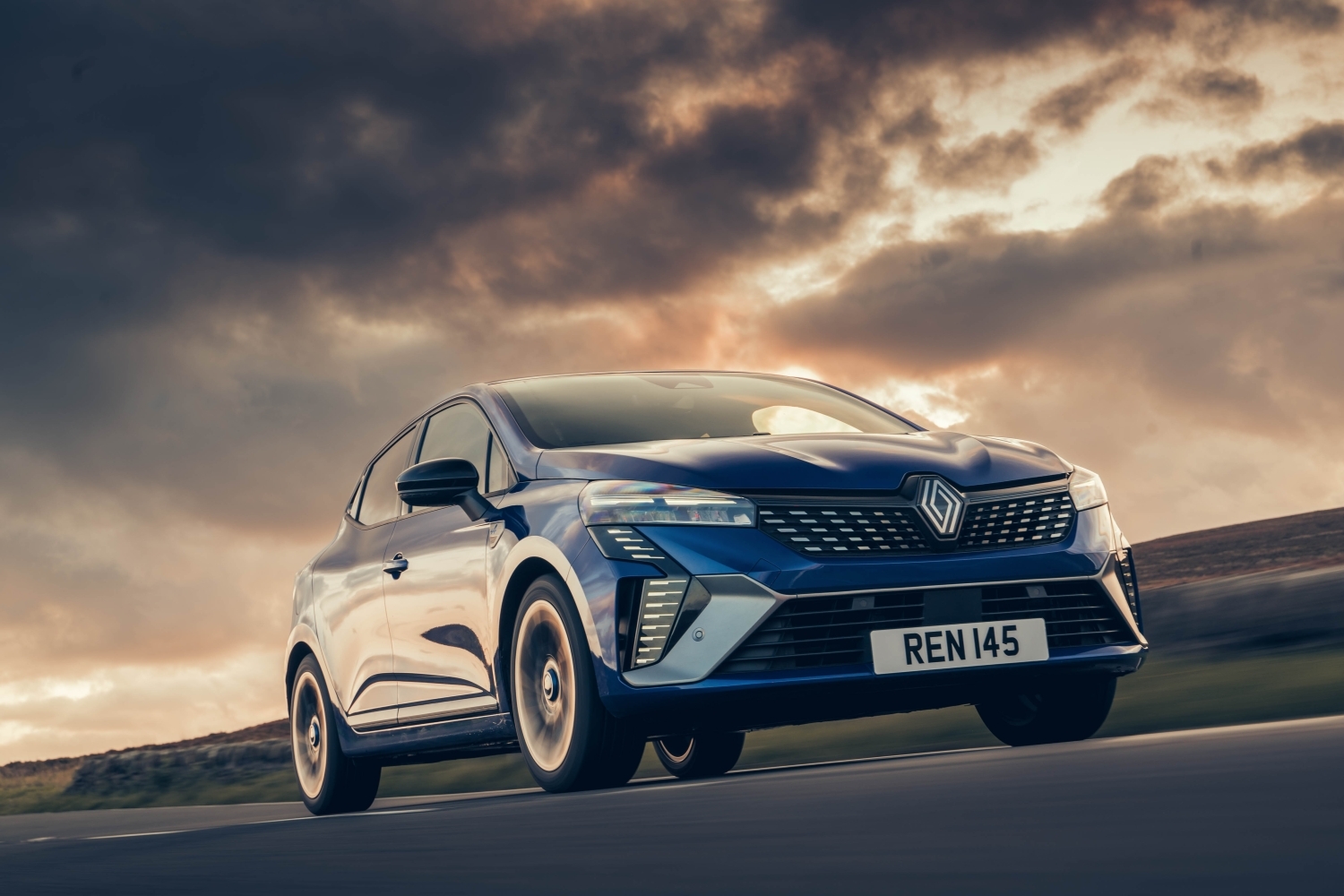
Euro NCAP: is the Renault Clio a safe car?
The Renault Clio was put through its crash test paces by Euro NCAP back in 2019, receiving the maximum five-star rating including seriously impressive 96% and 89% scores for adult and child occupant protection.
Although that rating is still deemed valid by the safety organisation, some newer rivals have had slightly more stringent standards applied to them. Still, the Clio beats out four-star rivals like the Peugeot 208 and Vauxhall Corsa, while matching the Toyota Yaris and Honda Jazz.
There’s no shortage of technology designed to stop you from having a crash in the first place, too. Every Clio gets autonomous emergency braking, lane keep assist, driver attention alert and traffic sign recognition, while useful kit such as blind-spot monitoring, rear cross-traffic alert and adaptive cruise control are added with Esprit Alpine spec.
You’ll want mid-range Techno trim and above if you want to avoid low-speed prangs. It upgrades the standard rear parking sensors to all-round sensors and adds in a reversing camera, too.
Fuel economy and running costs
Even the petrol Renault Clio is frugal and cheap to run, but the E-Tech Hybrid takes that another step further. It’s among the most efficient small cars out there in terms of fuel economy.
Official WLTP tests give the Clio a figure of 67.3mpg. That can’t quite match the lofty 70mpg the most efficient Toyota Yaris Hybrid matches in the same test, but it isn’t far off – and ahead of hybrid rivals like the Honda Jazz and MG 3 Hybrid+. It’s also usefully higher than the pure petrol Clio’s 54.3mpg official figure.
What makes the Clio so well-suited as a town car is that, like many full hybrids, you’re likely to get near this figure in urban driving where the blend of petrol and electric power is at its most effective. The downside is that you’re less likely to achieve it on the motorway.
While the Clio E-Tech can’t match plug-in hybrid alternatives for company car Benefit-in-Kind tax savings, its CO2 emissions of 96g/km put it in a more favourable tax band than most small car alternatives.
How much does the Renault Clio E-Tech Hybrid cost to insure?
Expect to pay a little bit more to insure the hybrid Renault Clio compared with the pure petrol model, but overall it’s unlikely to break the bank. The E-Tech 145 sits in insurance group 15 regardless of trim level, which is roughly in line with higher spec versions of the Toyota Yaris and a good few groups lower than the Honda Jazz.
Renault Clio E-Tech Hybrid FAQs
What is the Renault E-Tech Hybrid?
Renault’s E-Tech hybrid system is a full (or ‘self-charging’) hybrid system that uses a small battery to allow for a couple of miles of all electric town driving before the engine kicks in to recharge it. Renault claims 80% of urban drives can be completed in electric power alone.
What is the range of the Renault Clio E-Tech Hybrid?
You’ll struggle to get more than 2 or 3 miles of all-electric range from the Clio E-Tech Hybrid because the battery is only 1.2kWh. However, you never need to recharge it yourself as the engine always tops the battery up when it fires.
Is the Renault Clio Hybrid any good?
We reckon the Renault Clio Hybrid is a good, affordable small car for those who want smooth urban driving and good fuel economy. It’s decent to drive, has a pleasant interior and plenty of standard kit.

